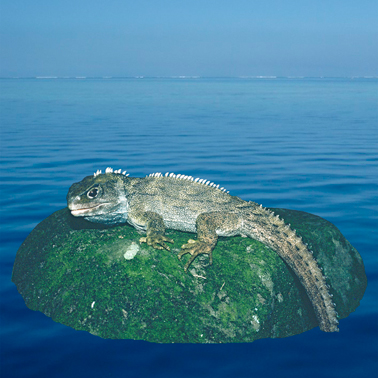The endangered New Zealand tuatara (Sphenodon) is a lizard-like reptile that is the only survivor of a group that was globally widespread at the time of the dinosaurs. The tuatara lives on 35 islands scattered around the coast of New Zealand, mainland populations having become extinct with the arrival of humans and associated animals some 750 years ago.
The oldest known Sphenodon fossil dates to the Pleistocene era (around 34,000 years old), while the new discovery dates to the Early Miocene some 19 to 16 million years ago (Mya).The fossil, of jaws and dentition closely resembling those of the present-day tuatara, bridges a gap of nearly 70 million years in the fossil record of the group between the Late Pleistocene of New Zealand and the Late Cretaceous of Argentina.

Tuatara sitting on a really tiny island. This humorous depiction is of an ancestral tuatara (Sphenodon) sitting on an exaggeratedly small piece of land during the height of the debated submergence of New Zealand. Photo by Alan J D Tennyson of a wild tuatara on Stanley Island; prepared and manipulated by Marc E H Jones.
In a paper published this week in the Proceedings of the Royal Society B, the team says that its findings offer further evidence that the ancestors of the tuatara have been on the landmass since it separated from the rest of the southern continents (Gondwana) some 82 Mya.
Lead author Dr Marc Jones, UCL Cell and Developmental Biology, says: "It has been argued that New Zealand was completely submerged during the Oligo-Miocene drowning of the continent some 25 to 22 million years ago (Mya). However, the diversity of fossils now known from the Miocene (St Bathans Fauna of the Manuherikia Group) suggests it is more likely that enough land remained above the water to ensure the survival of a number of species, such as frogs, kauri trees and several modern freshwater insects, as well as the tuatara."
"The fossil also provides the first direct evidence that the ancestors of the tuatara survived in New Zealand despite substantial climatic and environmental changes, such as a global temperature drop of some eight degrees celsius around 14 million years ago (Mid-Miocene).
"Between the Late Oligocene and earliest Miocene (35 to 22 Mya) a global sea-level rise submerged much of New Zealand, but the question is, by how much? If the continent of Zealandia was completely submerged, the Sphenodon would have had to recolonize it by ocean rafting. If we look at the transoceanic capabilities of modern Sphenodon, it can swim, but only short distances; it is able to survive without food for several months, but dehydration would be a serious problem for a long journey because of high rates of water loss through the skin. Furthermore, there is currently no evidence of a population outside New Zealand at that time.
"It seems more likely that some local land surface persisted during the drowning of the continent and allowed the ancestors of the tuatara along with some frogs, birds and mammals (known from the Miocene but now extinct) to survive the transgression, although the extent of the remaining land surface at the time is open to speculation. However, even if Zealandia was reduced to only one per cent of today's surface area it would still represent over 2,500 square kilometres, well over 1,000 times the surface area of Stephen's Island (1.5 km squared), where over 30,000 tuatara currently live."




Comments